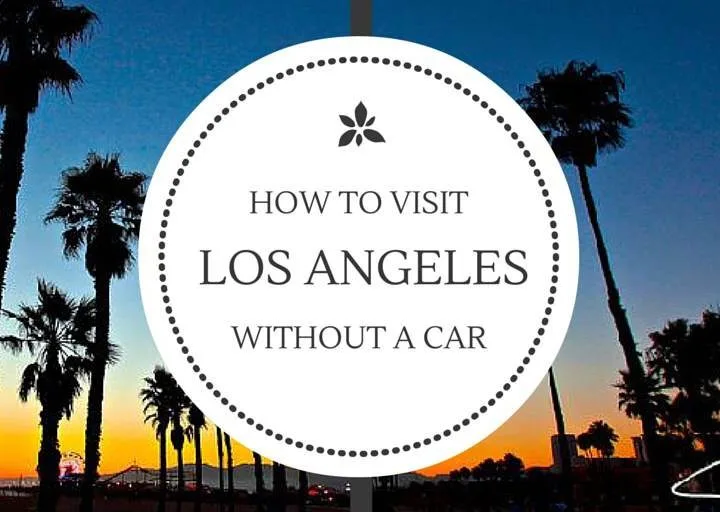Everyone in LA or outside of LA is absolutely convinced that you need to rent a car to visit Los Angeles. Yet, visiting Los Angeles without a car is totally doable if you can’t or don’t want to drive (and a much more sustainable option as well).
There are a few very common misconceptions: first, that the Los Angeles public transportation network is pretty much non-existent (False!).
Second, taking the bus is so dangerous that you are probably going to be killed (so very false!). And lastly, that buses are very dirty and smell bad (there are exceptions but in general it’s false).
GENERAL TIPS
If you are planning on relying on public transportation while in Los Angeles, it helps to be located in a central, well-linked neighborhood.
You might want to look for a hotel in Hollywood, Santa Monica, Westwood, or Midtown so it’ll be easier to move around.
Los Angeles is like any other big city, some neighborhoods are safer than others: avoid going to rough places after dark, just listen to your guts whenever and you won’t have any problems. I constantly took the bus while I was studying at UCLA and never had issues.
Pay a little more attention at night time, if you are a girl alone and/or you feel uncomfortable, you might want to sit or stand close to the driver.
It’s hard to figure out which bus to take and where to take it: The tools I find very useful to see how to get from place A to place B are the Metro Trip Planner (very easy to use) and the Go Metro Los Angeles V2, an app to use on the go (it’s downloadable on the AppStore and GooglePlay).
If you prefer, Google Route Planner on Google Maps does the trick as well (it works all around the world!).
THE BUS NETWORK
The Los Angeles bus network allows you to get pretty much anywhere in the city, but it can be difficult to navigate as it is actually composed by the city Metro company plus other municipal bus operators such as Big Blue Bus and other I’ve outlined below.
A general tip: remember to bring the exact change when you board a bus, drivers won’t give you any money back.
METRO BUS SYSTEM

Bus tickets cost $1.75, $2.50 if you board a Metro Express bus; if you plan on using the network quite a bit, it might be convenient to buy either a Metro Day Pass ($7) or a 7-Day Pass ($25).
You can’t buy a transfer to another Metro bus system but you can actually buy a transfer to a Big Blud bus or to other networks’ buses if you need to board it within 2 hours: just tell the driver that you need a transfer, it will only cost you $0.50.
There are 3 different types of Metro bus lines (I know, it sounds complicated but really it’s not), in total the network includes 200 different lines driving all around the Greater Los Angeles area.
You recognize the different types because they are painted differently:
- Metro Local buses are orange and make many stops on the way; pretty much they stop on each block, which means it can take a long time if you have to cross the whole city (going from Westwood to Downtown Los Angeles take 1 hour 15 minutes).
- Metro Rapid buses are red, make fewer stops, and are much faster.
- Metro Express buses are blue, and they are the fastest of all because they run on the freeway (stops are very far from each other of course).
In general use these to cover long distances, while choose the Metro Local and Metro Rapid if you don’t have to go too far.
DASH
The Dash Transit provides short-distance rides in Downtown and other Los Angeles neighborhoods.
DASH website says that “each route is designed to serve travel within that neighborhood and to connect to other regional transit services such as Metro Rapid and local routes, Metrolink and Metro rail lines”.
From a tourist point of view, you can use it especially to travel around Downtown, as tickets cost 50 cents.
Look at the schedules on DASH website.
BIG BLUE BUS
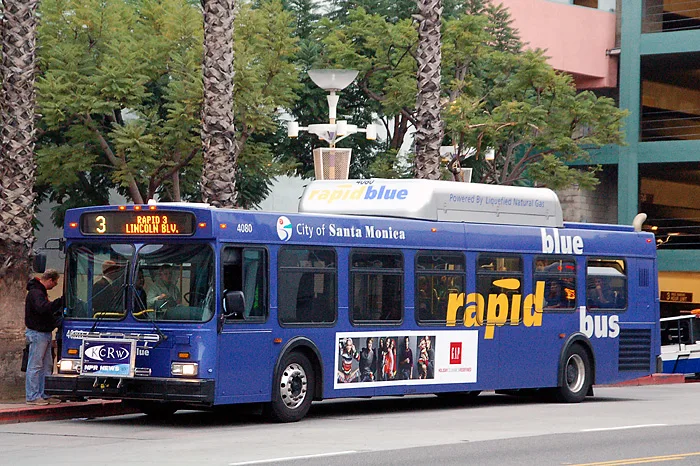
When you see a Big Blue Bus you recognize it immediately: as the name says, it’s bright blue!
The Big Blue Bus is the Santa Monica bus that operates linking multiple destinations, including Downtown Los Angeles, Mid-City, and LAX, to Santa Monica and the rest of Los Angeles Westside (which includes Century City, Westwood/UCLA, and Venice).
For example, if you are in the Westside and need to go and get the Metro Rail, you can just take a Big Blue Bus 7 to Pico station and transfer there.
When it is possible, I strongly suggest taking a Big Blue Bus rather than a Metro one: they are more modern, usually faster and cheaper (a one-way ticket costs 1$).
For $ 0.50 more you can purchase a transfer ticket which allows you to board free of charge in the following 2 hours a Metro Bus, Metro Rail, or a bus of these other companies: Beach Cities Transit, Culver City Bus, Foothill Transit, Gardena, Montebello, Santa Clarita Transit and Torrance Transit.
You CANNOT buy a transfer ticket if you have to board another Big Blue Bus, in this case you will have to buy two single tickets.
CULVER CITY BUSES
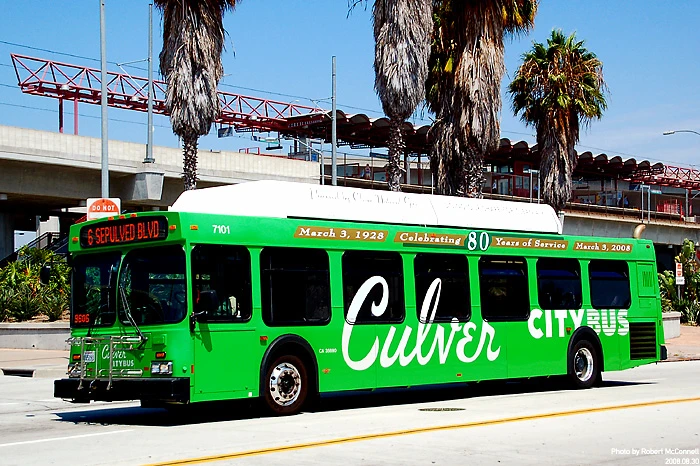
If we talked about blue buses before, this is the time of a fleet of buses painted bright green. Culver City Buses serve only the Los Angeles Westside area (Blair Hills, Century City, Culver City, Mar Vista, Marina Del Rey, Palms, Venice Beach, Westwood, and Westchester).
Some of the routes are very similar to the Metro buses’, but taking a Culver City Bus costs $1, and transfers to another Culver City Bus only $0.25 (always to be asked and to be paid for when you board the first bus).
You can also ask for a transfer to another company’s bus, in this case, the transfer costs $0.40 (for example, if you need to take a Culver City Bus then a Metro Bus or a Big Blue Bus, the ticket in total will cost $1.40, still cheaper than a single Metro Bus).
Just so you know, there are many other municipal companies in the Los Angeles Area serving specific areas and cities (did I tell you that the greater Los Angeles is an agglomerate of different cities?), but they are usually outside the tourist routes.
METRO RAIL SYSTEM
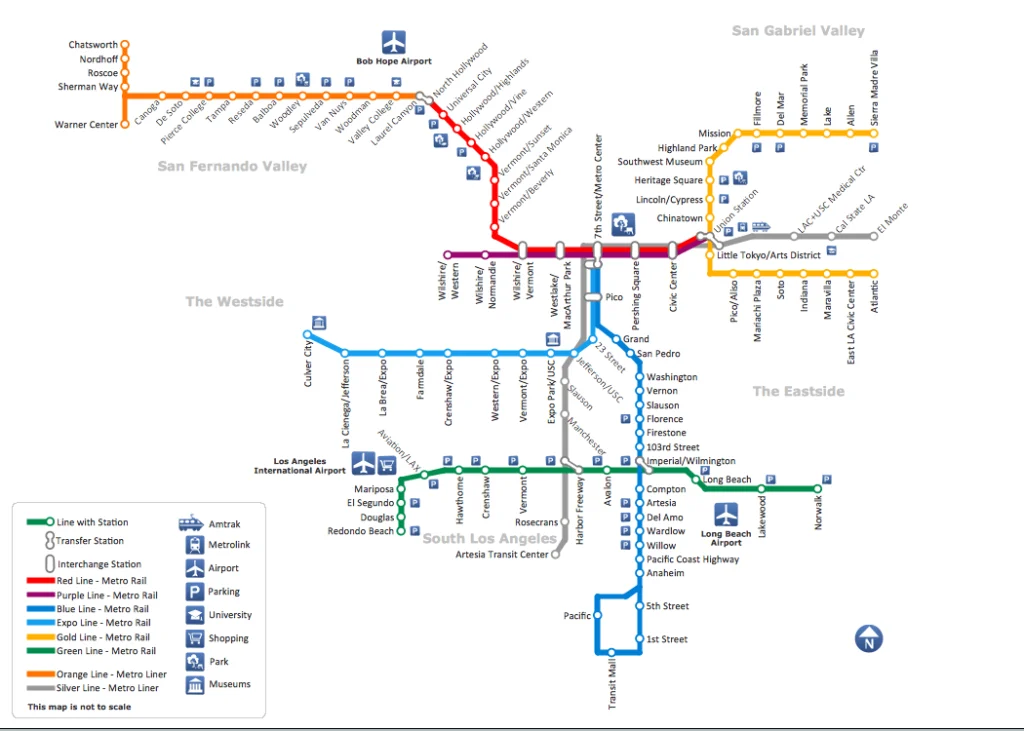
Who said that Los Angeles doesn’t have a subway?! The city has a Metro Rail System, but this is often overlooked because the Los Angeles area is so big that only a small part of it is covered by it (yet).
Nonetheless, as a tourist, you can make good use of it to get to several attractions.
WHAT TO SEE ON THE METRO RAIL RED LINE
Keen on art? Then get off at North Hollywood and check out the NoHo Arts District. You will probably want to check out the Universal Studios and the Universal CityWalk Hollywood (get off at Universal City stop).
Then head to Hollywood to look at the stars and dream about all the movies you’ve watched: the stop at Hollywood/Highland is good for exploring the Chinese Theatre, the Walk of Fame, and Madame Tussauds Museum.
To get an incredible view over the city head to Griffith Observatory: get off at Vermont/Sunset station and wait for the shuttle that brings you directly over there (on Saturday and Sunday only).
WHAT TO SEE ON THE METRO RAIL PURPLE LINE
Get off at the Wislhire/Western stop to check out the LACMA (Los Angeles County Museum of Art) and Koreatown.
Other popular destinations around Downtown LA include the Walt Disney Concert Hall and the MOCA (Museum of Contemporary Art), for which you need to get off at Civic Center station.
The Purple Line ends at Union Station, from which you can walk to Olvera Street and El Pueblo de Los Angeles.
WHAT TO SEE ON THE METRO RAIL GOLD LINE
If you want to explore Downtown Los Angeles you can either get off at Union Station or at Chinatown (for Geffen Contemporary or all those underground art galleries).
If you have time, I highly recommend going on a day trip to Pasadena by getting off at Memorial Park station.
WHAT TO SEE ON THE METRO RAIL BLUE LINE
Get off at Pico Station to access the Staples Center, Nokia Theatre and the Los Angeles Convention Center.
To visit the Watts Towers get off at 103rd St. Station (don’t go after dark and pay a little more attention to your surroundings than usual, as the towers are located in a rough area).
If you want to visit the Queen Mary and the Aquarium of the Pacific in Long Beach, get off at Transit Mall station.
WHAT TO SEE ON THE METRO RAIL EXPO LINE
The Metro Rail Expo Line is still in construction and currently links Downtown Los Angeles to Culver City; in 2015 the line will be extended to Santa Monica.
Get off at 7St/Metro Center to explore Downtown LA and at Pico station to visit the Staples Center.
HOW TO GET TO LAX: FLYAWAY, BUS AND METRO RAIL
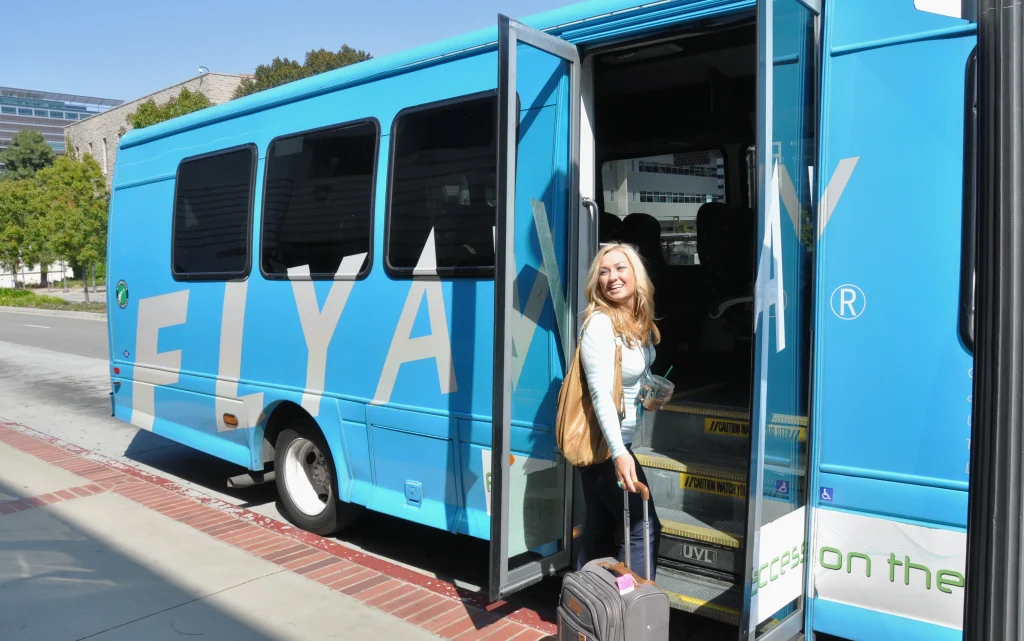
If you are coming or going to the airport your best bet will be to take a FlyAway bus: I took it several times going to/from Westwood/UCLA and it’s reliable and cheaper (the Westwood one costs $8) than the shared shuttles options (which cost on average 20-25$, depending on which area of the city you are going to).
There are 5 FlyAway lines, connecting:
– LAX to Union Station in Downtown Los Angeles
– LAX to Hollywood Boulevard
– LAX to Santa Monica Main Street
– LAX to Westwood/UCLA in West Los Angeles
– LAX to VanNuys Airport
If you are really on a budget you can get to the airport by using normal public transportation, just make sure you allow plenty of time because sometimes traffic in Los Angeles is really bad.
There are several options if you want to take the bus:
- Big Blue Bus to LAX: lines 3 or Rapid 3 link LAX to Marina del Rey, Venice, Santa Monica and Westwood
- Culver City Bus to LAX: line 6 goes from LAX to Westwood/UCLA along the Sepulveda corridor
- Torrance Transit to LAX: line 8 goes from LAX to Redondo Beach, Manhattan Beach, Torrance.
Buses do not arrive all the way to the airport: you will be dropped off at the Metro Bus Center where a free shuttle will bring you to the airport.
Passengers landing at LAX should wait for the “C” Shuttle outside the Arrival level (look for the LAX Shuttle & Airline Connections sign), which links LAX to the Metro Bus Center.
It’s also possible to connect directly with the Metro Rail.
Metro Rail to LAX: a free shuttle links the Metro Green Line Aviation Station to LAX. If you have just landed and need to get to the station, wait for the “G” Shuttle outside the Arrival level (look for the LAX Shuttle & Airline Connections sign).
